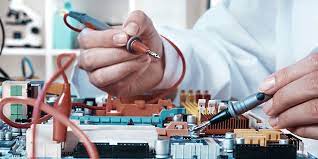Electronic technology is a broad term that encompasses the various types of electronic devices, including electrical circuits. There are several different fields of study, such as Electron Tube Technology, Analog and Digital Electronic Circuits, and Bipolar and Negative Feedback. It is important to understand the difference between these types of technology so that you can choose an area of study that interests you the most.
Electron tube technology
Electron tubes are an electro-mechanical device that is controlled by an electric field. It consists of electrodes and a vacuum chamber.
Electron tubes are used for a variety of applications. They can be found in TVs, computer monitors, and microwave technology. Compared to semiconductor devices, they can operate at higher temperatures and handle high power.
Electron tubes may be made from glass, ceramic, or metal. They can be sealed, making them easier to use.
The fundamental characteristics of vacuum tubes, such as low “drift,” remain constant over a wide range of operating conditions. However, performance measurements vary between tube models. This is due to the nonlinearities of electron tubes.
Another key advantage of electron tubes is their ability to withstand repeated arcing without damage. Aside from their many practical applications, they are also used to control millions of electrons.
Analog and digital electronic circuits
Digital and analog electronic circuits are two of the most common types of electronic circuits used in today’s technologies. These circuits are used in a variety of applications including televisions, calculators, radio and audio devices, and other devices.
Both kinds of circuits have their own advantages and disadvantages. The type of circuit used will depend on the specific application. A digital circuit uses digital signals and logic gates to process them. This means that the signals are processed in real time. However, the processing of these signals can be prone to error, which makes it less reliable than analogue circuits.
Generally, digital circuits have a smaller number of inputs and outputs. They are often used in control systems and mission-critical applications. Its main components are logic gates, and they use a binary (base 2) code to represent a set of data.
Negative feedback vs positive feedback
There are many types of feedback and there are two main ones. The first one is the negative feedback. It is a type of control theory where an input signal is subtracted from an output signal. This results in a reduction in gain, though not a complete loss.
The negative feedback is often used in amplifiers to improve the stability of gain. This is an important feature because amplifiers can be sensitive to DC drift. Another benefit of the negative feedback is the fact that it counteracts the effect of changes in characteristics caused by temperature.
The positive feedback is a slightly different story. In a positive feedback loop, a signal is fed back to the input. This acts as a control signal in the system.
Bipolar feedback
Bipolar feedback is an important component in electronic technology. It allows the transistor to function as a switch, digital IC, amplifier, filter, or rectifier. In addition to these applications, it also reduces the noise and distortion that plague some systems.
Feedback can be used to increase the system’s bandwidth. However, it can also reduce the gain of an amplifier. This tradeoff makes it an attractive part for some systems.
Feedback can improve the stability of an amplifier. It also increases predictability. Adding negative feedback to a common-emitter circuit, for example, can improve the reliability of the amplified signal.
Feedback is also the way that a signal flows from an output to an input in a circuit. There are two main paths through which the feedback can be introduced. The first involves a current-sense resistor.
Internships and co-ops
Internships and co-ops are great ways for engineering students to gain real-world experience. They offer a wide variety of benefits, including networking opportunities, a competitive salary, and the opportunity to earn academic credit.
The best time to search for internships and co-ops is before graduation. Students can find these opportunities through career fairs, Handshake, and personal contacts.
Both internships and co-ops are supervised by an employer. Internships require a commitment of ten weeks or more in the summer, and some are full-time during the semester. In contrast, co-ops are generally a yearlong, structured engagement with the same company.
If you want to get academic credit for your co-op, you must register with the college or university’s co-op program. Some universities may also waive tuition for students who are enrolled in the co-op program.
Are you looking trending Hindi digital magazine website? Must try MastiKiPathshala.
